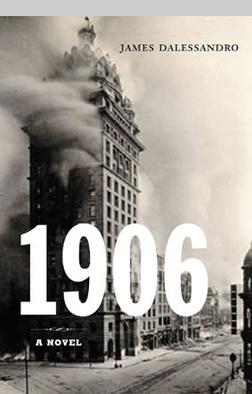
An earthquake – also called a quake, tremor, or temblor – is the shaking of the Earth's surface resulting from a sudden release of energy in the lithosphere that creates seismic waves. Earthquakes can range in intensity, from those so weak they cannot be felt, to those violent enough to propel objects and people into the air, damage critical infrastructure, and wreak destruction across entire cities. The seismic activity of an area is the frequency, type, and size of earthquakes experienced over a particular time. The seismicity at a particular location in the Earth is the average rate of seismic energy release per unit volume.

San Francisco is a 1936 American musical-drama disaster film directed by W. S. Van Dyke, based on the April 18, 1906 San Francisco earthquake. The film stars Clark Gable, Jeanette MacDonald and Spencer Tracy. MacDonald's singing helped make this film a major hit, coming on the heels of her other 1936 blockbuster, Rose Marie.

A natural disaster is the very harmful impact on a society or community after a natural hazard event. Some examples of natural hazard events include avalanches, droughts, earthquakes, floods, heat waves, landslides, tropical cyclones, volcanic activity and wildfires. Additional natural hazards include blizzards, dust storms, firestorms, hails, ice storms, sinkholes, thunderstorms, tornadoes and tsunamis. A natural disaster can cause loss of life or damage property. It typically causes economic damage. How bad the damage is depends on how well people are prepared for disasters and how strong the buildings, roads, and other structures are. Scholars have been saying that the term natural disaster is unsuitable and should be abandoned. Instead, the simpler term disaster could be used. At the same time the type of hazard would be specified. A disaster happens when a natural or human-made hazard impacts a vulnerable community. It results from the combination of the hazard and the exposure of a vulnerable society.

A disaster film or disaster movie is a film genre that has an impending or ongoing disaster as its subject and primary plot device. Such disasters may include natural disasters, accidents, military/terrorist attacks or global catastrophes such as a pandemic. A subgenre of action films, these films usually feature some degree of build-up, the disaster itself, and sometimes the aftermath, usually from the point of view of specific individual characters or their families or portraying the survival tactics of different people.

On October 17, 1989, at local time, the Loma Prieta earthquake occurred at the Central Coast of California. The shock was centered in The Forest of Nisene Marks State Park in Santa Cruz County, approximately 10 mi (16 km) northeast of Santa Cruz on a section of the San Andreas Fault System and was named for the nearby Loma Prieta Peak in the Santa Cruz Mountains. With an magnitude of 6.9 and a maximum Modified Mercalli intensity of IX (Violent), the shock was responsible for 63 deaths and 3,757 injuries. The Loma Prieta segment of the San Andreas Fault System had been relatively inactive since the 1906 San Francisco earthquake until two moderate foreshocks occurred in June 1988 and again in August 1989.

The Great Kantō earthquake also known in Japanese as Kantō daishinsai (関東大震災) struck the Kantō Plain on the main Japanese island of Honshū at 11:58:32 JST on Saturday, September 1, 1923. Varied accounts indicate the duration of the earthquake was between four and ten minutes. Extensive firestorms and a fire whirl added to the death toll.

The 1900 Galveston hurricane, also known as the Great Galveston hurricane and the Galveston Flood, and known regionally as the Great Storm of 1900 or the 1900 Storm, is the deadliest natural disaster in United States history. The strongest storm of the 1900 Atlantic hurricane season, it left between 6,000 and 12,000 fatalities in the United States; the number most cited in official reports is 8,000. Most of these deaths occurred in and near Galveston, Texas, after the storm surge inundated the coastline and the island city with 8 to 12 ft of water. As of 2025, it remains the fourth deadliest Atlantic hurricane on record, behind Hurricane Fifi of 1974. In addition to the number killed, the storm destroyed about 7,000 buildings of all uses in Galveston, which included 3,636 demolished homes; every dwelling in the city suffered some degree of damage. The hurricane left approximately 10,000 people in the city homeless, out of a total population of fewer than 38,000. The disaster ended the Golden Era of Galveston, as the hurricane alarmed potential investors, who turned to Houston instead. In response to the storm, three engineers designed and oversaw plans to raise the Gulf of Mexico shoreline of Galveston Island by 17 ft (5.2 m) and erect a 10 mi (16 km) seawall.

The Johnstown Flood, sometimes referred to locally as Great Flood of 1889, occurred on Friday, May 31, 1889, after the catastrophic failure of the South Fork Dam, located on the south fork of the Little Conemaugh River, 14 miles (23 km) upstream of the town of Johnstown, Pennsylvania, United States. The dam ruptured after several days of extremely heavy rainfall, releasing 14.55 million cubic meters of water. With a volumetric flow rate that temporarily equaled the average flow rate of the Mississippi River, the flood killed 2,208 people and accounted for US$17,000,000 in damage.

In legal usage in the English-speaking world, an act of God, act of nature, or damnum fatale is an event caused by no direct human action for which individual persons are not responsible and cannot be held legally liable for loss of life, injury, or property damage. An act of God may amount to an exception to liability in contracts, or it may be an "insured peril" in an insurance policy. In Scots law, the equivalent term is damnum fatale, while most Common law proper legal systems use the term act of God.

Storm Stories is an American non-fiction television series that airs on The Weather Channel (TWC) and Zone Reality. It is hosted and narrated by meteorologist and storm tracker Jim Cantore. Storm Stories showcases various types of severe weather, such as tornadoes, hurricanes, rain, floods, etc. Each episode features a famous severe storm, and survivors of it sharing their experiences. The program also features footage of the storm if it is available, but typically a re-enactment is used instead. The video of the storm is often shown while the survivors offer their accounts of it. Often, TWC would air a special week dedicated to one specific type of storm.

It Could Happen Tomorrow is a television series that premiered on January 15, 2006 on The Weather Channel. It explored the possibilities of various weather and other natural phenomena severely damaging or destroying America's cities. This included: a Category 3 hurricane hitting New York City, an F4 tornado destroying Washington, D.C., dormant volcano Mount Rainier re-activating and destroying towns in the surrounding valleys, a tsunami flooding the Pacific Northwest coast, an intraplate earthquake impacting Memphis, Tennessee, wildfires spreading into the heart of San Diego, a huge earthquake leveling San Francisco, a flash flood in Boulder, Colorado, and a flood in Sacramento. More recent episodes included an earthquake in Las Vegas, an F5 tornado ripping its way through Chicago and Dallas, and more.

Tropical Storm Frances caused extensive flooding in Mexico and Texas in September 1998. The sixth tropical cyclone and sixth named storm of the annual hurricane season, Frances developed from a low pressure area in the Gulf of Mexico on September 8. The cyclone moved northward through the western Gulf of Mexico, making landfall across the central Texas coastline before recurving across the Midwest through southeast Canada and New England. A large tropical cyclone for the Atlantic basin, yet an average sized system by western Pacific standards, the storm produced heavy rains across the Isthmus of Tehuantepec, Texas, western Louisiana and the Great Plains.

Abraham Lincoln Artman Himmelwright, a civil engineer, author, builder, adventurer, and marksman was the general manager of The Roebling Construction Company, the New York City firm created by John A. Roebling's Sons Company of Trenton, New Jersey. Himmelwright's first and second names were given to him by his parents to honor the slain president, Abraham Lincoln, assassinated the year Himmelwright was born. In most of the works he authored he went by the name "ALA Himmelwright".

At 05:12 AM Pacific Standard Time on Wednesday, April 18, 1906, the coast of Northern California was struck by a major earthquake with an estimated moment magnitude of 7.9 and a maximum Mercalli intensity of XI (Extreme). High-intensity shaking was felt from Eureka on the North Coast to the Salinas Valley, an agricultural region to the south of the San Francisco Bay Area. Devastating fires soon broke out in San Francisco and lasted for several days. More than 3,000 people died and over 80% of the city was destroyed. The event is remembered as the deadliest earthquake in the history of the United States. The death toll remains the greatest loss of life from a natural disaster in California's history and high on the list of worst American disasters.

The 1906 Meishan earthquake was centered on Moe'akhe, Kagi-cho, Japanese Taiwan and occurred on March 17. Referred to at the time as the Great Kagi earthquake, it is the third-deadliest earthquake in Taiwan's recorded history, claiming around 1,260 lives. The shock had a surface-wave magnitude of 6.8 and a Mercalli intensity of IX (Violent).

1906 is a 2004 American historical novel written by James Dalessandro. With a 38-page outline and six finished chapters, he pitched it around Hollywood in 1998 for a film by the same name, based upon events surrounding the great San Francisco earthquake and fire of 1906.

The Great Flood of 1913 occurred between March 23 and March 26, after major rivers in the central and eastern United States flooded from runoff and several days of heavy rain. Related deaths and damage in the United States were widespread and extensive. While the exact number is not certain, flood-related deaths in Ohio, Indiana, and eleven other states are estimated at approximately 650. The official death toll range for Ohio falls between 422 and 470. Flood-related death estimates in Indiana range from 100 to 200. More than a quarter million people were left homeless. The death toll from the flood of 1913 places it second to the Johnstown Flood of 1889 as one of the deadliest floods in the United States. The flood remains Ohio's largest weather disaster. In the Midwestern United States, damage estimates exceeded a third of a billion dollars. Damage from the Great Dayton Flood at Dayton, Ohio, exceeded $73 million. Indiana's damages were estimated at $25 million. Further south, along the Mississippi River, damages exceeded $200 million. Devastation from the flood of 1913 and later floods along the Mississippi River eventually changed the country's management of its waterways and increased federal support for comprehensive flood prevention and funding for flood control projects. The Ohio Conservancy Act, which was signed by the governor of Ohio in 1914, became a model for other states to follow. The act allowed for the establishment of conservancy districts with the authority to implement flood control projects.















